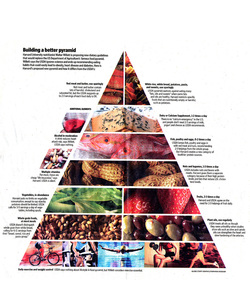
Oh well, I guess we shouldn't be surprised. After all, it's no secret that the processed food industry holds considerable sway over the USDA and related governmental agencies. Is it any wonder that the resulting "Dietary Guidelines" hold only a watery, vague resemblance to the actual nutritional science on which they are supposed to be based?
The good news is, of course, that we are free to completely ignore these "Guidelines" for supposedly healthy eating (which many truly healthy people have been doing for years), so I suggest you continue to do so - and here are 3 reasons why.
I couldn't have said it better myself! Dr. Katz then goes on to assert that the actual scientific report on which the Dietary Guidelines were supposed to be based is actually quite comprehensive and helpful.
Here are 3 ways in which the actual original report gets it right, while the final "Dietary Guidelines" document falls far short.
1. The Dietary Guidelines Don't Address Sustainability
For the first time, the 2015 Dietary Guidelines Advisory Committee (DGAC) Report addressed a difficult topic: How sustainable is the way we are eating?
If we continue to eat the way we have begun eating over the past 60-70 years, strong evidence suggests we (and our planet) will be in a whole lot of trouble very soon. Our modern meat-heavy diet, combined with the soil-destroying practices of modern "conventional" agriculture, are leading us down a path to literal destruction (of our resources, our planet, and our health). How we eat today determines what there will be to eat tomorrow, and if we do not address the sustainability issue (and sooner, rather than later), future generations will find life itself a whole lot more unsustainable.
So shouldn't this issue be reflected in the Dietary Guidelines? You would think so, but it isn't. As Dr Katz says, by choosing to ignore this issue, "...these are not dietary guidelines for “Americans,” as they claim to be. They are, instead, dietary guidelines for “the current generation of American adults,” and at the obvious expense of all subsequent generations of American (and planetary) adults – including, of course, our children."
2. The Dietary Guidelines Are Ridiculously Vague
While some previous iterations of the Guidelines included recommendations for consuming specific food groups (although in general terms), the new version seems intent upon avoiding the naming of any specific foods (hmmm...wonder why (*cough-special interests!*)), instead, emphasizing the importance of consuming more "nutrient dense foods." Huh?? What the heck is a "nutrient dense food"? Broccoli? Meatloaf? Energy bars? Who knows....
The guidelines about what not to eat are just as bad. We are advised to limit our intake of saturated fats, as well as added sugars, but when it comes to specific foods and ingredients to avoid, well...it doesn't say what those might be. In fact, what it does say rather nebulously is that we should continue to consume foods from "all food groups." Again, huh??
The Dietary Guidelines also helpfully include the idea of making healthful "shifts" by trading "bad" foods in our diet for better ones - but again, no specific examples are given, so we are left to guess about what we are supposed to trade for what....
While the original research document refers to many specific foods and food groups (in both the what-to-eat and what-not-to-eat columns), the actual Dietary Guidelines themselves are so vague as to be all but useless.
3. The Dietary Guidelines Almost Completely Disregard the Original Recommendations Regarding Meat Consumption
While the original DGRC Report provided clear recommendations to eat less meat for the sake of both our own health and the planet, the Dietary Guidelines offer only a watered down suggestion for men and boys in certain age groups to cut back a bit on meat consumption. They then go on to say that you should eat meat, poultry, and fish as good protein sources, in the interest of consuming foods "from all food groups."
They even say that processed meats (recently in the news for the carcinogenic chemicals they contain), are "okay," as long as you stay within the recommended nutrient thresholds!
When it comes right down to it, the 2015 Dietary Guidelines leave us more confused than ever when it comes to healthy eating. While we could simply continue to ignore them and eat whatever we want (which most people do anyway), doing so is certainly not doing us any favors, as the incidence of modern disease continues to skyrocket, with obesity, diabetes, cancer, and heart disease reaching new highs all the time. (But then again, I guess the interests that the "Dietary Guidelines" are looking out for are not yours and mine....)
Since the "guidelines" basically provide no practical guidance whatsoever about what to eat (or what not to eat), you may think you're on your own. But you're not - or at least, you're not without resources! You are in control of your own health - and your own healthy eating. I encourage you to check out the 2015 DGAC Report, which is in the public domain, and free for anyone to read.
And please continue to visit this blog, check out our Facebook pages (including Holistic Health Wire's page), and educate yourself about true health, and truly healthy eating. (For some very informative previous posts, just click on the "Food & Nutrition" category to the left.)
To your TRUE health!
Rose.



 RSS Feed
RSS Feed